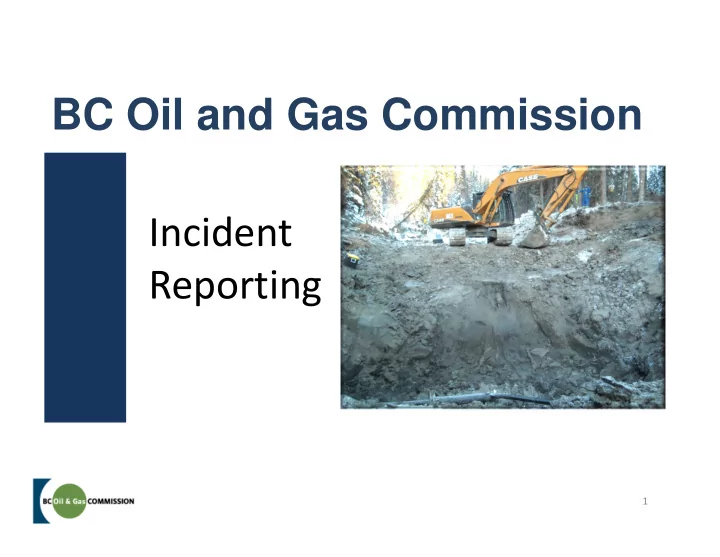

BC Oil and Gas Commission Incident Reporting 1
Incident Reporting: Systems and Processes Regulatory Framework In British Columbia, oil and gas incidents are managed in accordance with the following legislation and regulations: 1. The Oil and Gas Activities Act 2. The Emergency Management Regulation NOTE: CSA Z246.2 are adopted within the EMR. • 3. The Spill Reporting Regulation The Emergency Management Manual provides additional guidance on all aspects of the EMR and related regulation. Please see https://www.bcogc.ca/node/5767/download 2
Incident Reporting: Systems and Processes What is a reportable incident? • What are the timelines for reporting? • What are the differences in incident level? • Emergency Management BC – Major incident reporting • Kermit on-line incident reporting • DGIR’s & Spill Product Information • Incident Location Data • 3
Incident Reporting: Systems and Processes Reportable incidents • Any release of a substance in amounts exceeding the thresholds defined in the Spill Reporting Regulation see note • Any release of a substance into a lake, stream, river or ocean [in any volume] • Any release of sour product where measurement of 10ppm or greater is found, 1 meter or more from the source. • Any failure of an emergency or safety related system • Damage to equipment, with or without release. • Vandalism or security incident causing damage or interfering with a process control. • Well incidents including seismic, loss of circulation, pit gains NOTE: If spilled during loading or unloading from a vehicle (road or rail), federal thresholds may apply. 4
Incident Reporting: Systems and Processes Reporting Timelines • Minor incidents – Within 24 hours of discovery • Minor incidents are entered by the permit holder online • Incidents involving spills must first obtain a DGIR number by calling emergency Management BC (EMBC) • Emergency level incidents – Within one hour of discovery • Reported to the Commission through EMBC • Initial incident information entered by Commission staff 5
Incident Reporting: Systems and Processes Incident Levels Minor Incident: Smaller incidents, confined to lease site or right-of-way, very unlikely to escalate, no health impact to people or environment. No significant impact on operations. Level 1 Emergency: Potential or actual off-lease impact, very small possibility for escalation, some minor impact on operations, control of incident established or imminent. Emergency response is plan activated. Level 2 Emergency: More significant incident, with off-lease impacts and escalation possible. Control of the incident may not be established but is expected in the short term. Emergency response is plan activated. Level 3 Emergency: Most significant incident, with large scale impacts on and off lease, major equipment damage / failure, and potential life and safety impacts. Control and / or containment not likely in the short term. Emergency response is plan activated. 6
Incident Reporting: Systems and Processes Spill Incident Immediate Call Call EMBC for DGIR, 24 hours to enter Report on line Minor Incident Score of 1 or 2 No product spilled Enter within Report on line 24 Hours Spill Incident Immediate Emergency Incident Call to EMBC Get DGIR from EMBC Score of 3 or greater: Call EMBC No product Immediate spilled Call to EMBC Level 1, 2 or 3 emergency 7
Incident Reporting: Systems and Processes KERMIT Incident Reporting System From the Commission’s website, select “Online Services 8
Incident Reporting: Systems and Processes KERMIT Incident Reporting System Click on the KERMIT logo, then sign in and enter your incident information. For detailed guidance on using KERMIT, please see https://www.bcogc.ca/ node/11190/download For information on setting up access to KERMIT, please see documentation at https://www.bcogc.ca/node/8173/download 9
Incident Reporting: Systems and Processes Dangerous Goods Incident Report Sample DGIR form created by Emergency Management BC. Note the level of incident (Minor) and the risk score (1-2) provided as a range. 10
Incident Reporting: Systems and Processes Geographic References All incidents MUST be reported with a UTM location. Pipeline incidents are also entered with NTS or DLS “ To and From” locations, project and segment number, however the precise location of an incident must also be recorded. 11
Incident Reporting: Systems and Processes Summary: • All spills at or exceeding the thresholds noted in the Spill Reporting Regulation must have a Dangerous Goods Incident Report created. EMBC manages this process. • Minor incidents are reported by the permit holder directly into the KERMIT system. For spills, a DGIR must be attached to the on-line report. • All incidents must have a UTM location. • All major incidents (Emergencies) are reported to EMBC. The Commission’s duty emergency officer will follow up with the permit holder to obtain more information. • Failure to report a spill or other incident is a serious offence. Questions? Please e-mail us a emp@bcogc.ca 12
Recommend
More recommend